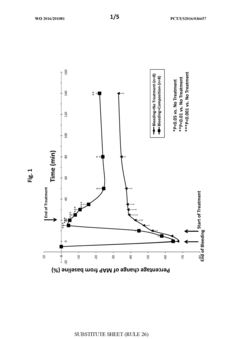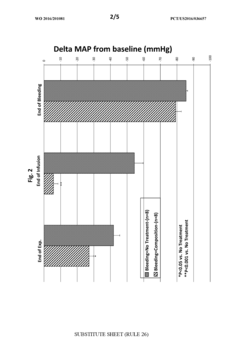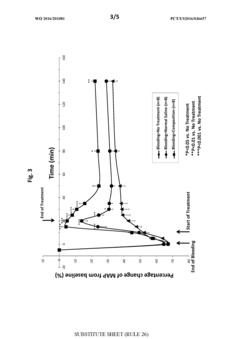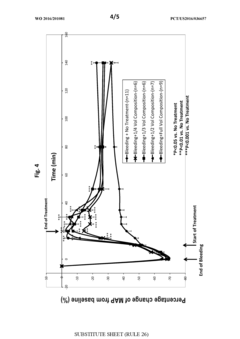How to Select the Right Hypertonic Solution for Medical Procedures?
Hypertonic Solutions in Medicine: Background and Objectives
Hypertonic solutions have played a crucial role in medical procedures for decades, offering a wide range of applications in various clinical settings. These solutions, characterized by their higher solute concentration compared to bodily fluids, have become indispensable tools in modern medicine. The evolution of hypertonic solutions can be traced back to the early 20th century when researchers began exploring osmotic pressure and its effects on biological systems.
The primary objective of utilizing hypertonic solutions in medical procedures is to create an osmotic gradient that facilitates the movement of fluids across cell membranes or between body compartments. This fundamental principle has led to the development of numerous therapeutic applications, including the treatment of cerebral edema, management of intracranial pressure, and rapid volume expansion in hypovolemic shock.
Over time, the composition and formulation of hypertonic solutions have undergone significant refinement to enhance their efficacy and safety profiles. Early solutions primarily consisted of sodium chloride, but advancements in medical research have led to the incorporation of various solutes such as mannitol, glucose, and hydroxyethyl starch. These developments have expanded the range of clinical scenarios where hypertonic solutions can be effectively employed.
The selection of the appropriate hypertonic solution for a specific medical procedure has become increasingly complex due to the growing number of available options. Factors such as the desired physiological effect, patient-specific considerations, and potential side effects must be carefully evaluated to ensure optimal outcomes. This complexity underscores the need for a comprehensive understanding of the underlying principles and current best practices in hypertonic solution selection.
Recent technological advancements have further expanded the potential applications of hypertonic solutions. For instance, the development of novel delivery systems and the integration of hypertonic solutions with other therapeutic modalities have opened up new avenues for treatment in fields such as oncology and regenerative medicine. These innovations highlight the ongoing evolution of hypertonic solutions and their continued relevance in addressing contemporary medical challenges.
As we delve deeper into the intricacies of selecting the right hypertonic solution for medical procedures, it is essential to consider the broader context of their use in modern healthcare. This includes examining the current market landscape, regulatory considerations, and emerging trends that may shape the future of hypertonic solution utilization. By comprehensively analyzing these factors, we can gain valuable insights into the optimal selection and application of hypertonic solutions across various medical scenarios.
Market Analysis of Hypertonic Solutions
The global market for hypertonic solutions in medical procedures has been experiencing steady growth, driven by increasing prevalence of conditions requiring osmotic therapy and the rising demand for advanced medical treatments. The market is segmented based on product types, including mannitol, hypertonic saline, and other specialized solutions. Each segment caters to specific medical needs and procedures, with hypertonic saline solutions holding a significant market share due to their versatility in treating various conditions.
Geographically, North America dominates the hypertonic solutions market, followed by Europe and Asia-Pacific. The United States, in particular, accounts for a substantial portion of the market revenue, attributed to its advanced healthcare infrastructure and high adoption rates of innovative medical technologies. Emerging economies in Asia-Pacific, such as China and India, are expected to witness rapid market growth due to improving healthcare access and increasing investments in medical research and development.
The market is characterized by the presence of both established pharmaceutical companies and specialized manufacturers. Key players in the industry are focusing on product innovations, strategic collaborations, and mergers and acquisitions to strengthen their market position. The competitive landscape is evolving with the entry of new players offering novel formulations and delivery systems for hypertonic solutions.
Factors driving market growth include the rising incidence of traumatic brain injuries, increasing surgical procedures, and the growing geriatric population prone to neurological disorders. Additionally, the expanding applications of hypertonic solutions in emergency medicine and critical care settings are contributing to market expansion. However, the market faces challenges such as stringent regulatory requirements and the potential side effects associated with certain hypertonic solutions.
The COVID-19 pandemic has had a mixed impact on the hypertonic solutions market. While elective procedures saw a temporary decline, the increased focus on critical care and emergency medicine during the pandemic has sustained demand for these solutions. The pandemic has also accelerated research into novel applications of hypertonic solutions, potentially opening new avenues for market growth.
Looking ahead, the market is poised for further growth, with technological advancements in formulation and delivery methods expected to drive innovation. The development of personalized hypertonic solutions tailored to specific patient needs and conditions represents a promising trend. Moreover, increasing awareness among healthcare professionals about the benefits of hypertonic solutions in various medical procedures is likely to fuel market expansion in the coming years.
Current Challenges in Hypertonic Solution Selection
The selection of appropriate hypertonic solutions for medical procedures presents several significant challenges in contemporary healthcare settings. One of the primary difficulties lies in the diverse range of available hypertonic solutions, each with unique properties and applications. This variety, while beneficial for tailored treatments, complicates the decision-making process for healthcare professionals.
A critical challenge is the need for precise concentration management. Hypertonic solutions, by definition, have a higher solute concentration than body fluids. However, the optimal concentration varies depending on the specific medical procedure, patient condition, and desired therapeutic outcome. Achieving the right balance is crucial to avoid potential adverse effects while maximizing therapeutic benefits.
Patient-specific factors further complicate the selection process. Individual variations in fluid and electrolyte balance, underlying medical conditions, and potential drug interactions must be carefully considered. This necessitates a personalized approach to hypertonic solution selection, which can be time-consuming and requires extensive clinical expertise.
The dynamic nature of a patient's condition during medical procedures adds another layer of complexity. The ideal hypertonic solution at the start of a procedure may not remain optimal throughout its duration, requiring healthcare providers to reassess and potentially adjust their choice in real-time.
Moreover, the potential side effects of hypertonic solutions pose a significant challenge. These can range from minor electrolyte imbalances to severe complications such as hypernatremia or central pontine myelinolysis. Balancing the therapeutic benefits against these risks requires careful consideration and monitoring.
The storage and preparation of hypertonic solutions also present practical challenges. Many solutions have specific storage requirements and limited shelf lives. Proper handling and preparation are crucial to maintain solution integrity and prevent contamination, adding to the complexity of their use in clinical settings.
Lastly, the economic aspect of hypertonic solution selection cannot be overlooked. Cost considerations, including not only the price of the solutions themselves but also the potential expenses associated with managing any complications, play a role in decision-making, particularly in resource-constrained healthcare environments.
In conclusion, selecting the right hypertonic solution for medical procedures involves navigating a complex interplay of factors including solution properties, patient characteristics, procedural requirements, and practical considerations. Addressing these challenges requires a multifaceted approach combining clinical expertise, patient-specific assessment, and ongoing research to optimize the use of hypertonic solutions in medical care.
Existing Methods for Hypertonic Solution Selection
01 Hypertonic solutions for medical treatments
Hypertonic solutions are used in various medical treatments, including wound care, osmotherapy for reducing intracranial pressure, and as a component in dialysis fluids. These solutions have a higher solute concentration than body fluids, which can help draw excess fluid from tissues or create specific therapeutic effects.- Hypertonic solutions for medical treatments: Hypertonic solutions are used in various medical treatments, including wound care, reducing intracranial pressure, and treating dehydration. These solutions have a higher solute concentration than body fluids, which can help draw excess fluid from tissues and promote healing.
- Hypertonic solutions in cell culture and biotechnology: Hypertonic solutions play a crucial role in cell culture techniques and biotechnology applications. They are used for cell preservation, cryopreservation, and manipulating cellular osmotic pressure in various experimental procedures.
- Hypertonic solutions for diagnostic purposes: Hypertonic solutions are utilized in diagnostic procedures, such as contrast-enhanced imaging and osmotic stress tests. These solutions can help improve visibility in medical imaging or assess the function of certain organs and systems.
- Formulation and preparation of hypertonic solutions: Various methods and compositions for formulating hypertonic solutions are described, including the use of specific solutes, stabilizers, and preservatives. These formulations aim to enhance the effectiveness and stability of hypertonic solutions for different applications.
- Hypertonic solutions in food and beverage industry: Hypertonic solutions find applications in the food and beverage industry for processes such as osmotic dehydration, food preservation, and flavor enhancement. These solutions can help extend shelf life and improve the quality of various food products.
02 Hypertonic solutions in cell culture and preservation
Hypertonic solutions play a crucial role in cell culture techniques and preservation of biological materials. They are used to create osmotic stress in cells, study cellular responses, and as components in cryopreservation media for long-term storage of cells and tissues.Expand Specific Solutions03 Hypertonic solutions for diagnostic purposes
Hypertonic solutions are utilized in various diagnostic procedures, such as in contrast agents for imaging studies and in tests to evaluate renal function. These solutions can enhance visibility of specific structures or assess the body's response to osmotic changes.Expand Specific Solutions04 Formulation and preparation of hypertonic solutions
The development of hypertonic solutions involves careful formulation to achieve the desired osmolality and therapeutic effects. This includes selecting appropriate solutes, determining optimal concentrations, and ensuring stability and safety of the final product for various applications.Expand Specific Solutions05 Industrial applications of hypertonic solutions
Hypertonic solutions find applications in various industrial processes, including food preservation, water treatment, and as components in certain manufacturing processes. These solutions can be used to control microbial growth, extract water from materials, or create specific chemical environments for industrial reactions.Expand Specific Solutions
Key Manufacturers and Suppliers of Hypertonic Solutions
The selection of hypertonic solutions for medical procedures is a critical area in healthcare, currently in a mature development stage with a growing market size. The technology's maturity is evident from the involvement of established pharmaceutical companies like Novartis AG and medical device manufacturers such as Medtronic. Research institutions like The Cleveland Clinic Foundation and universities are actively contributing to advancements in this field. The competitive landscape is diverse, with players ranging from large corporations to specialized biotech firms like Abraxis BioScience LLC and Cellphire, Inc. The market is characterized by ongoing innovation, with companies like B. Braun Melsungen AG and Fresenius Medical Care Deutschland GmbH focusing on developing improved solutions for various medical applications.
Novartis AG
The Cleveland Clinic Foundation
Innovative Approaches in Hypertonic Solution Development
- A composition comprising specific salts, natural or synthetic sugars, and a high molecular weight, non-ionic, hydrophilic polymer, which can be administered as a solid or liquid, effectively increasing intravascular volume and pressure, suitable for both therapeutic and prophylactic use, particularly in conditions like traumatic brain injury and hypovolemia, without causing renal impairment.
- Development of chemically stable parenteral pharmaceutical compositions comprising GLP-1/GLP-2 dual agonists with specific formulations that include a non-ionic or ionic tonicity agent like mannitol or NaCl, along with a phosphate buffer, to maintain isotonicity and stability, ensuring the peptides remain stable and effective during storage and administration.
Safety and Efficacy Considerations
When selecting the right hypertonic solution for medical procedures, safety and efficacy considerations are paramount. The choice of solution must balance therapeutic effectiveness with minimal risk to the patient. Osmolality is a critical factor, as solutions with excessively high osmolality can cause tissue damage and pain upon administration. The ideal osmolality range varies depending on the specific procedure and patient characteristics.
The composition of the hypertonic solution plays a crucial role in both safety and efficacy. Solutions containing electrolytes, such as sodium chloride, are commonly used due to their compatibility with human physiology. However, the concentration of these electrolytes must be carefully controlled to prevent electrolyte imbalances or adverse reactions. In some cases, non-electrolyte solutions like mannitol may be preferred, particularly when cerebral edema is a concern.
The pH of the solution is another important consideration. Solutions with pH values close to physiological range (7.35-7.45) are generally safer and better tolerated. Extreme pH values can cause local tissue irritation or systemic acid-base disturbances. Buffer systems may be incorporated to maintain pH stability during storage and administration.
The route of administration significantly impacts safety and efficacy. Intravenous administration requires sterile, pyrogen-free solutions to prevent infection and inflammatory responses. For topical applications, such as wound irrigation, the solution's effect on tissue healing and microbial control must be evaluated. The duration of exposure to the hypertonic solution also influences its safety profile, with prolonged contact potentially leading to adverse effects.
Patient-specific factors must be taken into account when selecting a hypertonic solution. Pre-existing conditions, such as renal impairment or cardiovascular disease, may contraindicate certain solutions or necessitate dose adjustments. Age, body weight, and fluid status are additional factors that influence the choice and dosing of hypertonic solutions.
The intended therapeutic effect guides the selection process. For instance, hypertonic saline for treating hyponatremia requires a different approach compared to mannitol for reducing intracranial pressure. The onset of action, duration of effect, and potential for rebound phenomena are all critical efficacy considerations that vary among different hypertonic solutions.
Lastly, the potential for drug interactions and compatibility with concurrent medications or interventions must be evaluated. Some hypertonic solutions may alter the pharmacokinetics or pharmacodynamics of other drugs, potentially compromising safety or efficacy. Comprehensive assessment of these factors ensures the selection of the most appropriate hypertonic solution for each specific medical procedure and patient scenario.
Regulatory Framework for Hypertonic Solutions
The regulatory framework for hypertonic solutions plays a crucial role in ensuring patient safety and efficacy in medical procedures. In the United States, the Food and Drug Administration (FDA) oversees the approval and regulation of hypertonic solutions as medical devices or drugs, depending on their intended use and composition.
Under the Federal Food, Drug, and Cosmetic Act (FD&C Act), hypertonic solutions are typically classified as either Class II or Class III medical devices. Class II devices require a 510(k) premarket notification, demonstrating substantial equivalence to a legally marketed predicate device. Class III devices, considered high-risk, must undergo a more rigorous premarket approval (PMA) process.
The FDA's Center for Devices and Radiological Health (CDRH) is responsible for evaluating the safety and effectiveness of hypertonic solutions used in medical procedures. Manufacturers must comply with Good Manufacturing Practices (GMP) and adhere to quality system regulations to ensure consistent product quality and safety.
In the European Union, hypertonic solutions fall under the Medical Device Regulation (MDR) or the In Vitro Diagnostic Regulation (IVDR), depending on their intended use. The CE marking process requires manufacturers to demonstrate compliance with essential requirements, including safety, performance, and risk management.
Internationally, the International Organization for Standardization (ISO) provides guidelines for the development and manufacturing of medical devices, including hypertonic solutions. ISO 13485 specifically addresses quality management systems for medical devices, ensuring consistency in production and safety standards across different regions.
Regulatory bodies also require post-market surveillance and reporting of adverse events related to hypertonic solutions. This ongoing monitoring helps identify potential safety issues and informs updates to regulatory requirements and clinical guidelines.
The selection of hypertonic solutions for medical procedures must consider these regulatory frameworks to ensure compliance and patient safety. Healthcare providers and manufacturers must stay informed about evolving regulations and guidelines to maintain compliance and optimize patient outcomes.



